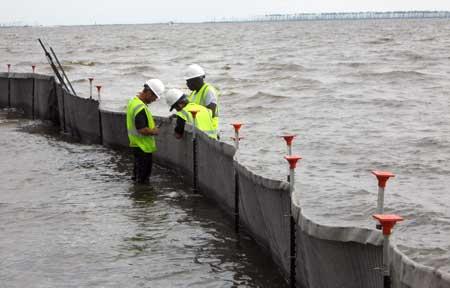|
THE recent Gulf oil spill was the largest accidental marine oil spill in the history of the petroleum industry. With an estimated 4.9 million barrels of crude oil released into the Gulf of Mexico the effects on the environment, wildlife, fishing and tourism industries are still being felt today.
It would be easy to say that nothing good came of this disaster. However, one thing that the Gulf oil spill showed was that there are thousands of ideas out there to help combat such events. When BP called for submissions to help fight the oil spill they were inundated with more than 40,000. Teams of scientists were set up to evaluate the ideas and ultimately only a handful made it to deployment. X-Tex was one of them.
Recently Mark Shaw from UltraTech International, responsible for getting X-Tex deployed during the Gulf oil spill, was in New Zealand speaking to Maritime New Zealand and other organisations involved with marine oil spill response. Shaw explains how X-Tex works and how it differs from traditional oil absorbents.
“X-Tex is a highly efficient, lipophilic (“oil attracting”) lightweight fibre matrix made from 100 percent recycled synthetic fibres that absorb an average of 20 times its weight in liquid hydrocarbons. What makes it different from traditional oil-only polypropylene is that, as well as being lipophilic, it’s also hydrophilic (“water attracting”). This means water passes through the fabric freely while absorbing hydrocarbons.
“Where X-Tex came into its own was along coastlines, where it was installed as a spill barrier. Tidal water was able to flow back and forward through the fabric and oil was absorbed by the X-Tex. It was even able to absorb hard-to-capture emulsified oil created by the dispersants used in the open ocean,” says Shaw.
Thirty miles of X-Tex Spill Barrier fencing was installed, with another 150 miles about to be deployed when the well was capped. In addition, to the Spill Barrier, UltraTech International used X-Tex to make shoreline oil blankets, floating absorption booms, and skirted booms that were able to remove emulsified oils in the watering column.
“Not only is X-Tex able to absorb more oil, faster than prolypropylene, around 85 to 90 percent of the oil can be reclaimed and the X-Tex material reused,” explains Shaw.
He says in the US UltraTech was able to inpregnate the X-Tex with “oil eating microbes” that help bio-remediate spills and clean the fabric. “These naturally occuring microbes are raised on a diet of sweet Texas crude and enable us to supercharge Mother Nature by getting them into the right place in large quantities.
“We’re currently working with our New Zealand distributor, Dalton International, to get these microbes approved for use in New Zealand,” says Shaw.
The unique benefits of X-Tex were proven in the Gulf of Mexico and now X-Tex is available in New Zealand.
|
Enquiries: Darryl Burn
Marketing Manager
Dalton international Ltd
Ph: (09) 263 3142
Mob: 021 225 1248
Email: darryl@daltoninternational.co.nz
|






